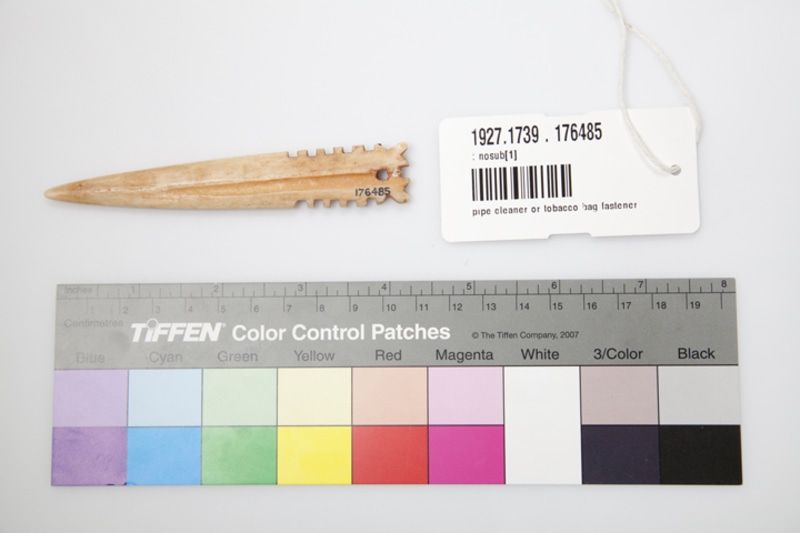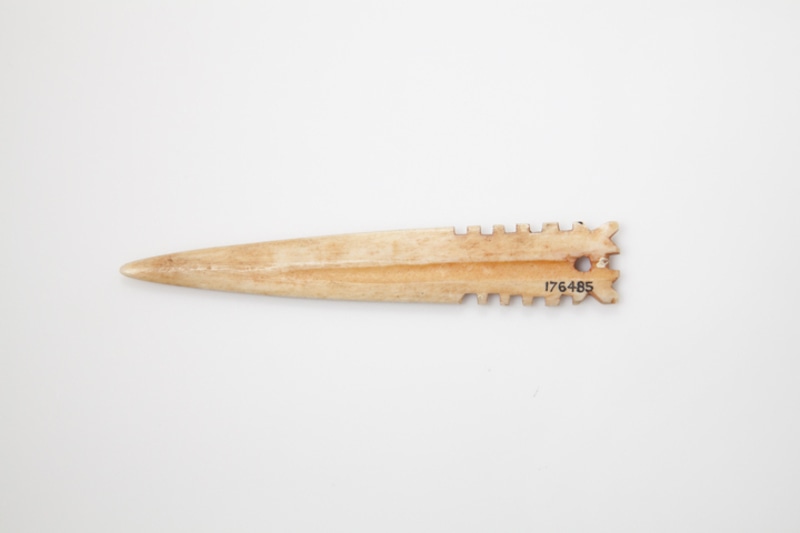pipe cleaner or tobacco bag fastener Item Number: 1927.1739 . 176485 from the The Field Museum



Translation Of Citations From Vanstone (1982) Article
« Tobacco pouches, particularly the roll-up variety, were frequently closed with the aid of fasteners which also served as pipe cleaners. There are 13 of these in the Speck collection and they are quite similar, consisting of a narrow piece of bone tapered or pointed at one end with a suspension hole at the other. Usually the neck constricts and there is a series of notches around the suspension hole. Another characteristic is parallel or crossed incised lines below the suspension hole. »
Vanstone, James W. "The Speck Collection of Montagnais Material Culture from the Lower St. Lawrence Drainage, Quebec." Fieldiana. Anthropology. New Series, No. 5 (October 29, 1982), p.13.
« les deux modèles les plus méticuleusement produits viennent de la bande des Nastaquan (fig. 9e,i). »
Vanstone, James W. "The Speck Collection of Montagnais Material Culture from the Lower St. Lawrence Drainage, Quebec." Fieldiana. Anthropology. New Series, No. 5 (October 29, 1982), p.13, fig 9i (p.37).
Citations From Vanstone (1982) Article
« Tobacco pouches, particularly the roll-up variety, were frequently closed with the aid of fasteners which also served as pipe cleaners. There are 13 of these in the Speck collection and they are quite similar, consisting of a narrow piece of bone tapered or pointed at one end with a suspension hole at the other. Usually the neck constricts and there is a series of notches around the suspension hole. Another characteristic is parallel or crossed incised lines below the suspension hole. »
Vanstone, James W. "The Speck Collection of Montagnais Material Culture from the Lower St. Lawrence Drainage, Quebec." Fieldiana. Anthropology. New Series, No. 5 (October 29, 1982), p.13.
« The two most carefully made specimens are from the Natasquan band (fig. 9e,i). »
Vanstone, James W. "The Speck Collection of Montagnais Material Culture from the Lower St. Lawrence Drainage, Quebec." Fieldiana. Anthropology. New Series, No. 5 (October 29, 1982), p.13, fig 9e (p.37).
Item History
- Made in Pekuakami, Lac Saint-Jean, Lake St. John, Labrador, Canada
What
- Name
- pipe cleaner or tobacco bag fastener
- Identification Number
- 1927.1739 . 176485
- Type of Item
- pipe cleaner or tobacco bag fastener
- Material
- bone
Who
- Culture
- Montagnais-Naskapi
Where
- Holding Institution
- The Field Museum
- Made in
- Pekuakami, Lac Saint-Jean, Lake St. John, Labrador, Canada
Other
- Nom De L'objet
- Nettoyeur à pipe ou attache de blague à tabac
- Matériaux
- os
- Ethnic Group
- Montagnais-Naskapi
- Collection
- Lake St. John Objects
- Provenience
- North America, Canada, Quebec, Labrador, Lake St. John